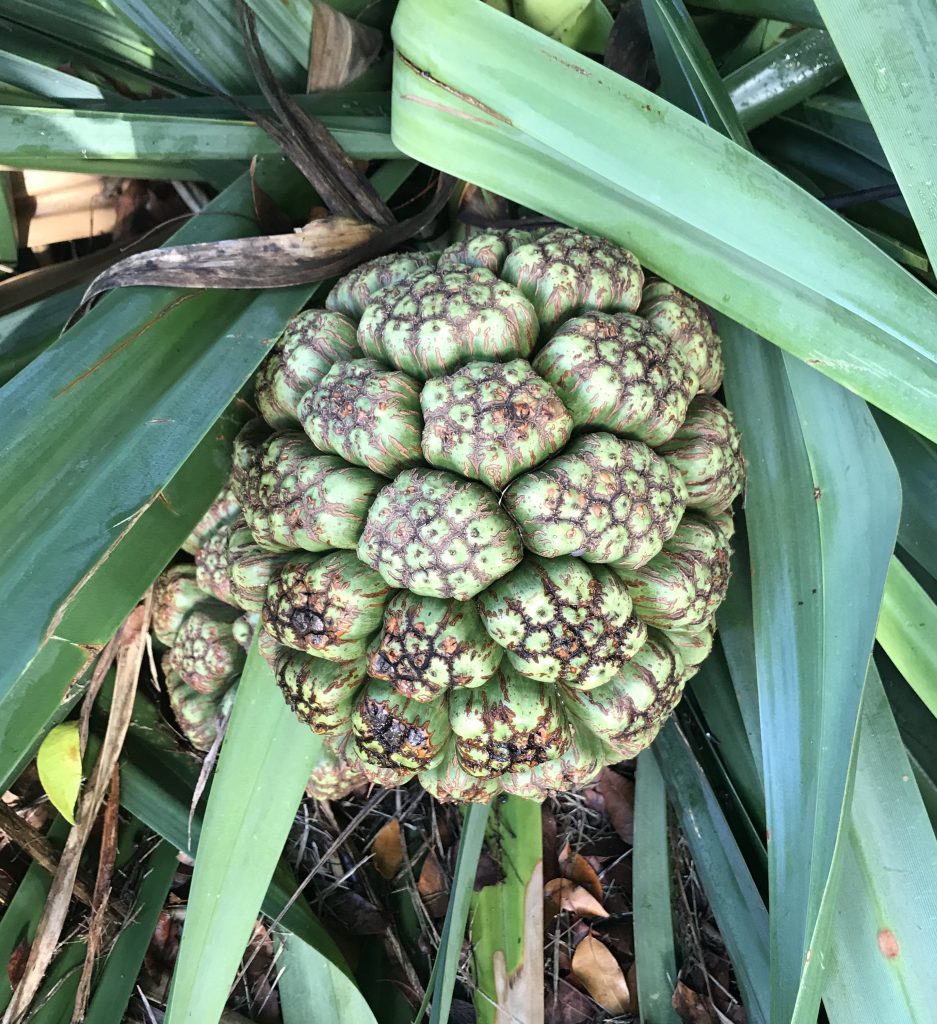
Unripe Pandanus Grass. Photo by Green Deane
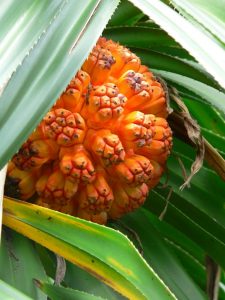
Ripe Pandanus is easy to spot.
The question every time you see one is which species is it? There are some 600 of them in the genus and several are edible one way or another. The one we saws this past weekend in Dreher Park sometimes had a little bit of calcium oxalate in the fruit and sometimes doesn’t. So one has to taste it carefully. What you do is take a section, which is a cluster of smaller parts, and chew it. The goal is to get the juice out of it more than anything else though some pulp is edible. Last year this particular growth lightly burned my lips enough to notice but not bothersome. Three species are commonly known as edible: Pandamus amaryllifolius, which it probably was not, Pandanus fascicularis, a good possibility as is Pandanus tectorius. The latter is the most consumed of all and it would be a good find. One of the more interesting things about the Pandanus is how it burns when lit. A dried Pandanus stalk can smolder for days like a baseball bat-sized cigarette. It was how some of the Aboriginals of Australia carried fire from one place to another. Among other sighting in the park were Coco-plums and Simpson Stoppers both just starting their seasonal run. The Sea-grapes were still green. They ripen around the first of September. The Mahoes were not yet in blossom though we did find one. They are unusual in that their blossom is yellow in the morning then turn red in the afternoon. Botanist tell us that is to attract different pollinators. The blossoms also have more antioxidants in the afternoon.
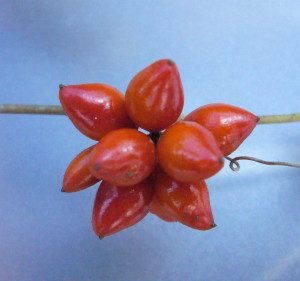
The red berries of Smilax walteri. Photo by Green Deane
Smilax has moved into its lesser time of year. Considered by many to be one of the best spring time greens the tips this time of year can be bitter and or peppery. Cooking moderates that. Interestingly Smilax is not a vine, at least not botanically. It is considered a climbing shrub. There are two groups with that classification in Florida, the Smilax and the Nickerbean. Apparently they have multiple trunks and grow about 12 feet long. This qualifies them as a shrub by some thinking. The ripe berries are marginally edible and I have not heard of any non-edible Smilax. That said I don’t eat red-berried Smilax because they are rather singular locally (and it has to have red berries for a reason even if I don’t know it.) I just don’t see Smilax walteri too often so I tend to let it be. There is a different red-berried Smilax species on Crete — S. aspera — and those berries are eaten. S. aspera also has male and female plants. To read more about Smilax go here.

Classes are held rain or shine.
Foraging classes this week include two favorite places, Red Bug Slough in Sarasota and Boulware Springs Gainesville.
Saturday, July 18th, Red Bug Slough Preserve, 5200 Beneva Road, Sarasota, FL, 34233. 9 a.m. to noon. We meet at the picnic table by the kids’ play area.
Sunday, July 19th, Boulware Springs Park, 3420 SE 15th St., Gainesville, FL 32641. 9 a.m. to noon. We meet at the pavilion near the spring house.
Sunday, July 25th, Eagle Park Lake, 1800 Keene Road, Largo, FL 33771. Meet at the pavilion near the dog park. 9 a.m. to noon.
Sunday, July 26th, Wickham Park: 2500 Parkway Drive, Melbourne, FL 32935-2335. Meet at the “dog park” inside the park. 9 a.m. to noon.
For more information, the pre-pay for a class, or sign up go here.
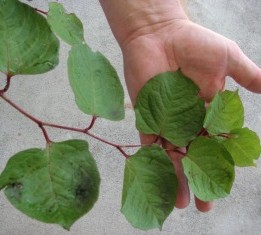
Japanese Knotweed. Photo by Green Deane
I am not sure it was with interest or amusement when I read about the Olympic Knotweed Working Group in Port Hadlock, Washington state. They have a knotweed problem that requires organization to combat it. That reminded me of the the Olympic stadium virtually half way around the world in London. It was a site of knotweed infestation and under British law the soil had to be removed and dealt with severely. That added 70 million pounds to the cost of building that stadium. That’s way in excess of $100 million dollars. Knotweed can break up concrete so it really had to be removed completely where the stadium was built. In Washington state there’s was an on-going study of how various herbicides and their application can kill of this edible weed. It’s fairly common in cooler climates and I’ve see a lot of it in the Carolinas. If I remember correctly it is also a commercial source of the anti-oxidant resveratrol. If you want to know more about knotweed click here.
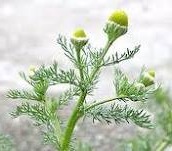
Driveway loving Pineapple Weed
I was given cause recently to reminisce about Pineapple Weed. The first thing is what did they call it before everyone knew what pineapples smelled like? (Pineapples, by the way, are native to South America, not Hawaii.) Pineapple Weed was once called “Disc Mayweed” but that appears to be of botanical extraction. “Wild Chamomile” is another name and more accurate but at one time all Chamomile was wild. “Rayless Chamomile” was also used though I’m sure the locals called it something else. And the botanists are still in flux with some calling it Marticaria discodea instead of Matricaria matricarioides. Personally I would go with M. discodea than M. matricatioides because the latter is not at all descriptive, inventive nor imaginative. In fact it is rather lazy. It’s Dead Latin that means it looks like itself. It would be as if my official botanical name was Green Deane Who Looks Like Green Deane. At any rate Pineapple Weed should be sprouting up in all of North America except for four states, Texas, Georgia, Alabama and Florida. I personally know this tea-making plant will not grow in Florida. I have smuggled it in from Maine and tried to keep a pot of it growing, much to the horror of Native Plant Society folks. Have no fear: It did not escape. It died from the heat. Back home it struggled every year to grow in our glacial dirt driveway. Tenacious, tough, small and yes smelling of pineapples. It will be growing near you. Look around foot paths, driveway, and bare ground. To read more about the Pineapple Weed go here.
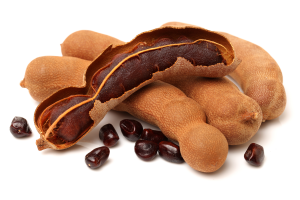
Sweet and tangy Tamarind fruit.
Plant beggars can’t be choosy? When Paul Dreher was given the task of landscaping the 100 acres that is now the park bearing his name, he had no budget. He took hand outs, donations, seeds and scrounged debris piles. This might account for some of the more unusual plantings in the park. At the north entrance of the park, for example, there are 22 Tamarind trees at the traffic circle (and at least two more on the south end of the park.) If you were given 22 Tamarind trees what would you do with them? Tamarindus indica, is from warm Africa. Today it is commonly found in South Asia and Mexico. India is the world largest producer of Tamarind. Its nutritious pods are consumed raw and cooked and is one of the current flavor darling of many avant-garde restaurants. The flavor is distinctive, both sweet and sour. The tree itself is slow-growing and long- lived. Without its annual pods the tree can easily hide, moderate in size, not too distinct. Interestingly few trees in the greater pea family are edible with the Tamarind and the Eastern Red Bud being two exceptions. If you want to see 22 of them…
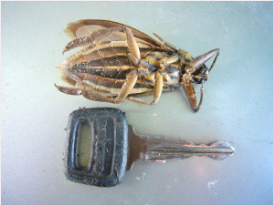
Toe Biter and a 2.5 inch car key. Photo By Green Deane
You couldn’t tell by its drying body on the sidewalk that it is a delicacy in Thailand. In fact that’s what confusing. Toe Biters are an aquatic insect and this not only was on dry land (so to speak) but had wings… When you eat them in a Thai snack shop they come all cooked and one doesn’t notice much about their anatomy except they are insects. So I sent a photo of the deceased to an entomologist friend who confirmed it is what locals call a Toe Biter (so called because they sometimes nip at the toes of bathers.) She wrote: “You are exactly right, it is a Belostomatid. They fly well, so you can find them in dry areas. They breath air even if they are aquatic bugs. They have the means to bite (piercing style) since they are totally carnivorous. They may eat other insects but can go for vertebrates as well such as fish and tadpoles.” Seems to me eating a Toe Biter is the best revenge … on par with eating sand spurs. If you want to read more about edible insects including the Toe Biter click here.

Green Deane videos are now available on a USB.
Changing foraging videos: As my WordPress pages are being updated the video set will go away. My nine-DVD set of 135 videos has been selling for seven years. They are the same videos I have on You Tube. Some people like to have a separate copy. The DVD format, however, is becoming outdated. Those 135 videos plus 15 more are now available on a 16-gig USB drive. While the videos can be run from the DVDs the videos on the USB have to be copied to your computer to play. They are MP4 files. The150-video USB is $99 and the 135-video DVD set is now $99. The DVDs will be sold until they run out then will be exclusively replaced by the USB. This is a change I’ve been trying to make for several years. So if you have been wanting the 135-video DVD set order it now as the price is reduced and the supply limited. Or you can order the USB. My headache is getting my WordPress Order page changed to reflect these changes. We’ve been working on it for over three weeks. However, if you want to order now either the USB or the DVD set make a $99 “donation” using the link at the bottom of this page or here. That order form provides me with your address, the amount — $99 — tells me it is not a donation and in the note say if you want the DVD set or the USB.

Green Deane Forum
Want to identify a plant? Perhaps you’re looking for a foraging reference? You might have a UFO, an Unidentified Flowering Object, you want identified. On the Green Deane Forum we — including Green Deane and others from around the world — chat about foraging all year. And it’s not just about warm-weather plants or just North American flora. Many nations share common weeds so there’s a lot to talk. There’s also more than weeds. The reference section has information for foraging around the world. There are also articles on food preservation, and forgotten skills from making bows to fermenting food. This is weekly newsletter 414, If you want to subscribe to this free newsletter you can find the sign-up form in the menu at the top of the page.
To donate to the Green Deane Newsletter click here.

